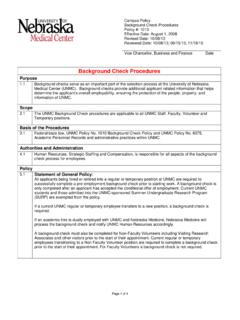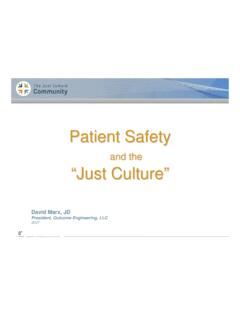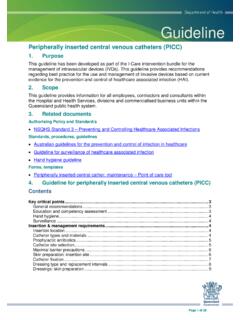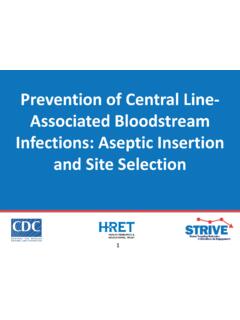Transcription of Staphylococcus aureus Bloodstream Infection Treatment ...
1 Staphylococcus aureus Bloodstream Infection Treatment Guideline Purpose: To provide a framework for the evaluation and management patients with Methicillin-Susceptible (MSSA) and Methicillin-Resistant Staphylococcus aureus (MRSA) Bloodstream infections (BSI). The recommendations below are guidelines for care and are not meant to replace clinical judgment. The initial page includes a brief version of the guidance followed by a more detailed discussion of the recommendations with supporting evidence. Also included is an algorithm describing management of patients with blood cultures positive for gram-positive cocci. Brief Key Points: t ignore it Staphylococcus aureus isolated from a blood culture is never a patients with S.
2 aureus in their blood should be treated with appropriate antibiotics andevaluated for a source of the infected catheters and prosthetic devices Retention of infected centralvenous catheters and prosthetic devices in the setting of S. aureus bacteremia (SAB) hasbeen associated with prolonged bacteremia, Treatment failure and death. These shouldbe removed if medically of prosthetic material is associated with an increased likelihood ofSAB relapse and removal should be considered even if not clearly for metastatic infections (endocarditis, osteomyelitis, abscesses, etc.) Metastatic infections and endocarditis are quite common in SAB (11-31% patients withSAB have endocarditis). patients should have a thorough history taken and exam performed with anynew complaint evaluated for possible metastatic should be strongly considered for all patients with patients with a prosthetic valve, pacemaker/ICD present, or persistentbacteremia (follow up blood cultures positive)
3 Should undergo atransesophageal clearance Repeat blood cultures 48-72 hours after initial positive cultures todocument clearance of bacteremia as SAB may persist even when fever has a repeat blood cultures are a predictor for metastatic Infection or endocarditisand should prompt an in-depth investigation for these repeat blood cultures are positive do not repeat more frequently than every 48-72hours4. Treat with the right drug at the right dose Place patients on the most effective therapy as soon as possible a. If Methicillin-susceptible S. auerus (MSSA) use a beta-lactam i. Oxacillin 2g q4h (preferred) ii. Non-severe beta-lactam allergy: Cefazolin 2g q8h b. If Methicillin-resistant S.
4 aureus (MRSA) use vancomycin routinely i. Vancomycin 15 mg/kg q12h ii. Do not change therapy based on vancomycin MIC c. Patients who are not responding to therapy after 5-7 days may be considered for change to an alternative agent (daptomycin preferred) 5. Treat for the right duration Failure to treat SAB for an adequate duration results in increased rates of relapse and trends toward increased Treatment failure a. The minimum Treatment duration for uncomplicated SAB (see #6 below for definition) is 2 weeks, generally IV, but the majority of patients should receive 4-6 weeks of therapy 6. Involve Infectious Disease early Studies have shown that ID involvement in the management of SAB is associated with improved detection of metastatic Infection and adherence to Treatment guidelines with decreased relapse rates and mortality Gram-positive cocci Blood Culture Treatment Algorithm Patients who have not been initiated on antimicrobials and have a blood culture positive for Gram-positive cocci should be evaluated and treated based upon the algorithm below.
5 Patient with 1 of 2 blood cultures positive for Gram-positive cocci (GPC) in clusters Clinically Unstable (hypotension or signs of sepsis) Clinically Stable Await Rapid Blood culture ID (BCID) before starting antibiotics Start Vancomycin* BCID Results: S. aureus +, any Staphylococcus genus result BCID Results: mecA + BCID Results: mecA - Start Vancomycin* Start oxacillin* BCID Results: S. aureus neg, Staphylococcus genus positive or negative, mecA positive or negative No antibiotics - clinically monitor Clinical worsening, hypotension or second blood culture positive for gram-positive cocci in clusters Continues clinically stable and only 1 of 2 blood cultures positive No antibiotics indicated * See dosing guidance below Management of Staphylococcus aureus Bacteremia 1.
6 Recommended Therapy for S. aureus Bacteremia a. MSSA: Studies have shown that Treatment with vancomycin is associated with increased mortality risk compared to beta-lactam therapy even when therapy was altered after culture results identified MSSA. Convenience of vancomycin dosing does not outweigh the potential benefits of beta-lactams in Treatment of MSSA bacteremia. (Schweizer et al. BMC Infect Dis. 2011;11:279-286) i. Preferred First -line: Oxacillin 2 g IV q4h 1. Penicillin G 4 million units IV q4h while clinically equivalent should not be used unless the presence of an inducible beta-lactamase has been ruled out by the microbiology lab (available by request) ii. Safe in those with non-severe penicillin allergy: Cefazolin 2 g IV q8h 1.
7 MSSA isolates are considered susceptible to other beta-lactams such as ampicillin/sulbactam, piperacillin/tazobactam, cefepime, ceftriaxone, ertapenem, and meropenem. There is a lack of clinical data supporting the use of these agents in bacteremia, but in mixed infections they are considered active and the addition of another agent such as vancomycin is unnecessary. iii. Third-line: Vancomycin 15 mg/kg IV q12h (first line for severe PCN allergy) b. MRSA: i. Preferred First-line: Vancomycin 15 mg/kg IV q12h 1. Vancomycin should not be avoided based on elevated but susceptible MIC values (see #7 below for when to consider alternative therapy) 2. Trough levels of 15-20 should be targeted and consultation with pharmacy is recommended.
8 Ii. Second-line: Daptomycin 6 mg/kg IV q24h 2. Additional antimicrobial agents a. The routine addition of agents such as rifampin or gentamicin is not recommended i. Gentamicin use provides little clinical benefit and has been associated with increased nephrotoxicity even when only used for a short time (Cosgrove SE, et al. Clin Infect Dis. 2009;48:713-21) ii. Rifampin use is associated with increased drug interactions and toxicity but it does have a role in infections where prosthetic devices are present such as prosthetic heart valves, pacemakers, or prosthetic joints 1. Rifampin should not be added without the input of the infectious disease team 2. Rifampin should NEVER be used alone as resistance rapidly develops 3.
9 Repeat blood cultures in 48-72 hours to document clearance of bacteremia a. Positive repeat blood cultures are a predictor for endocarditis and metastatic Infection and should prompt an in-depth investigation for these conditions b. Continue to repeat blood culture no more frequently than every 48-72 hours until clearance is achieved 4. Catheter and Prosthetic Device Management a. S. aureus has many virulence factors which allow it to colonize and infect metal and plastic surfaces and catheters and other prosthetic devices are often infected by S. aureus without any clinical signs of Infection b. Any prosthetic device or intra-vascular catheter present at the time of SAB should be considered infected until that Infection is ruled out i.
10 An attempt should be made to remove all prosthetic devices. In one study the retention of indwelling foreign bodies was associated with an 18-fold increase in the risk of S. aureus BSI relapse. (Fowler VG, et al. Clin Infect Dis. 1999;179:1157-61.) c. Catheter management i. Short-term Catheter: All catheters present at the time of bacteremia should be removed immediately if possible ii. Long-term Catheter: All catheters should be removed unless there are major contraindications (lack of alternative venous access, patient has significant bleeding diathesis, or quality of life issues take priority over the need for reinsertion of a new catheter at another site) d. Other prosthetic material i.
















